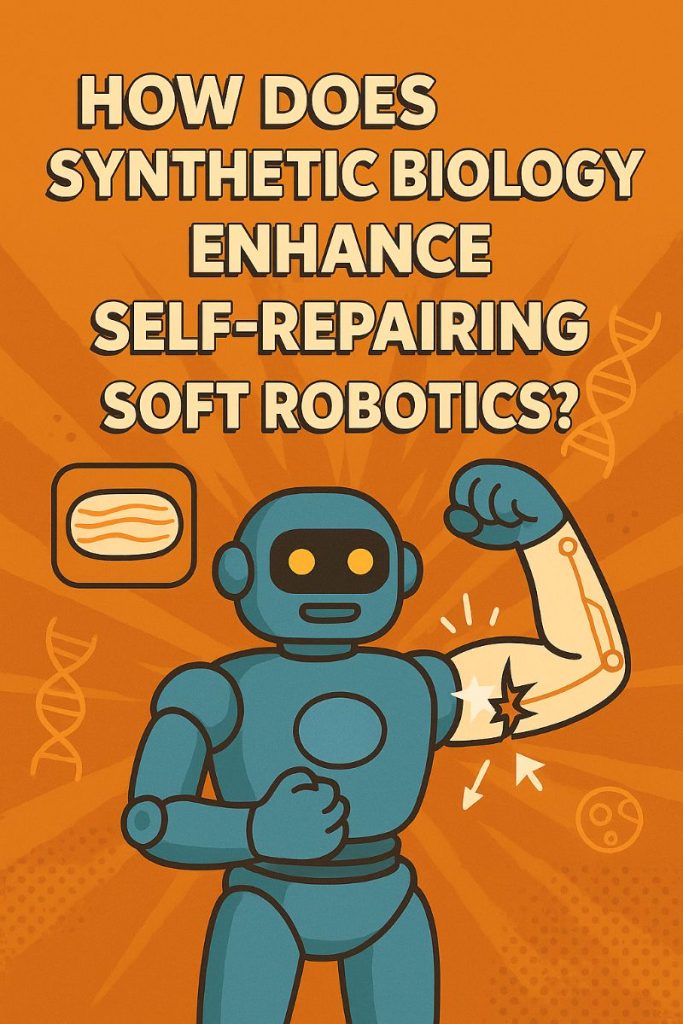Table of Contents
Intro: Sci-fi? Nah, It’s Real Now
What the Heck Is Synthetic Biology, Anyway?
Soft Robots: Squishy but Mighty
The “Self-Repairing” Bit — Yeah, It’s Wild
So How Does SynBio Fit In?
Real-Life Examples (No Lab Coats Needed)
What This Means for the Future (Spoiler: It’s Cool)
Related Tech That’s Also Insane
FAQs About Synthetic Biology and Soft Robots
Final Thoughts: We’re Basically Living in a Comic Book
1. Intro: Sci-fi? Nah, It’s Real Now
Okay. Imagine your robot vacuum runs into a chair leg too hard, rips itself, and then… heals. Like it’s Wolverine or something.
Sounds fake? Yeah, I thought so too. But turns out — it’s actually happening. Thanks to synthetic biology, soft robots (you know, the ones that look more like plush toys than Terminators) can now fix themselves. No duct tape needed.
2. What the Heck Is Synthetic Biology, Anyway?
Alright, don’t let the term scare you off. Synthetic biology (or “synbio” if you’re feelin’ fancy) is basically scientists remixing biology like a DJ — tweaking DNA and cellular stuff to make living systems do new things. Like grow a new arm. Or make plastic-eating bacteria. Or… give robots healing powers.
Yep, we’re in that era now.
3. Soft Robots: Squishy but Mighty
These aren’t your metal-and-wires kind of robots. Soft robotics is all about machines made from squishy materials — think silicone, rubber, or even biomaterials. Why? ‘Cause sometimes, the job needs a little flexibility. Literally.
They’re used in surgery, space stuff, search and rescue — even underwater missions. You name it. Their soft bods let them squeeze through tight spaces or handle delicate things like human organs without breaking anything (or anyone).
4. The “Self-Repairing” Bit — Yeah, It’s Wild
So here’s where it gets cool-slash-creepy. Researchers are combining synthetic biology with soft robotics to make these squishy bots self-heal. Like, automatically. No tools, no hands, just… healing.
Imagine a soft robot arm gets a gash while helping in a disaster zone. Normally? It’s done. Now? The materials inside actually regrow or reconnect, like skin stitching itself back together.
Kinda like Deadpool. But PG-rated.
5. So How Does SynBio Fit In?
Here’s the tea: Synthetic biology gives these robots the blueprint to regenerate. It’s like giving them living instructions.
Scientists engineer cells or materials that mimic biological tissue. These “bio-bits” can sense damage, trigger a healing response, and then rebuild the damaged area. All by themselves. No babysitting required.
Oh, and some of these systems even include programmable proteins — kind of like building Legos with logic. They know when to activate and how to fix stuff based on what’s happening around them.
6. Real-Life Examples (No Lab Coats Needed)
So far, we’ve seen soft robots that patch themselves in minutes using bio-gels. Others use synthetic muscle fibers that literally reconnect when torn. Like Velcro, but with science.
One team even built a robot with bioengineered tissues that can regrow after being sliced. Imagine if your phone screen did that after every drop.
By the way, this ties in with other wild tech — check out photonic computing in robotic vision. That’s another brain-melter.
7. What This Means for the Future (Spoiler: It’s Cool)
So… what now?
Well, self-repairing soft robots are already making waves in medicine. Think surgical bots that can fix themselves mid-op. Or soft exosuits that don’t need repairs every time you bump into a wall.
Military? Disaster response? Deep sea exploration? Yeah — all getting upgrades. And once they pair this tech with swarm systems or blockchain coordination (like this), the possibilities go bonkers.
Also, swarm robotics is getting a quantum boost too — if you wanna go down that rabbit hole, read this article on quantum computing and path planning.
8. Related Tech That’s Also Insane
Just so you know we’re not living in just one sci-fi movie:
Photonic brains in robots. Literally light-speed thinking.
Blockchain-controlled robot teams. No overlords needed.
Quantum AI for real-time decision making.
Needless to say, tech isn’t just evolving — it’s mutating. In a good way (we hope).
9. FAQs About Synthetic Biology and Soft Robotics
Q1: Can soft robots really repair themselves?
Yup. With synthetic biology, they can detect damage and literally grow new parts. No duct tape, no downtime.
Q2: Is synthetic biology dangerous?
Like anything powerful, it can be. But in soft robotics? It’s being used for healing, not harm.
Q3: Are these robots alive?
Not in the “feed-me-seymour” way. But they do have biological parts that behave like living tissue. Weird? Yes. Awesome? Also yes.
Q4: Where are self-repairing robots used right now?
Mostly labs and research projects. But soon? Think surgery, space travel, and disaster zones.
Q5: What materials are used?
Soft silicone, hydrogels, protein-based goo (not a joke), and lab-grown tissues.
Q6: Can these bots feel pain?
Nope. But they can detect damage. So like… robot instincts? Sorta.
Q7: How is synthetic biology different from regular biology?
Regular biology studies life. Synthetic biology builds life. Like God 2.0 — but with code.
Q8: Could this tech be used in humans someday?
Probably. We’re already seeing self-healing skin research using similar methods.
Q9: What powers these bots?
Batteries, sometimes solar, and sometimes biological fuels. Depends on the design.
Q10: Is there more to learn about synthetic biology in robotics?
Totally. Dive deeper with this detailed Deep Diverse article.
10. Final Thoughts: We’re Basically Living in a Comic Book
Let’s be real — 10 years ago, if someone said “soft robots will heal themselves using biology,” we’d laugh, sip our lattes, and swipe away.
But now? That’s literally happening. And it’s just the beginning.
Between synbio, quantum AI, and blockchain robot armies (yep, it’s a thing), the future isn’t coming. It’s already here. Hope you’re ready for it, because it’s squishy, self-healing, and smart as hell.

